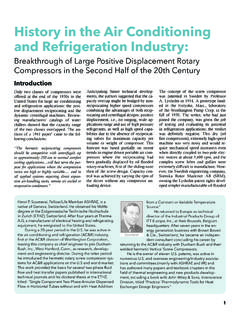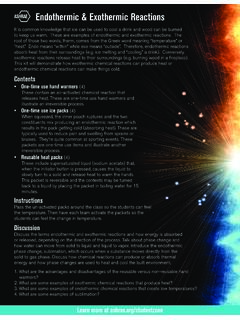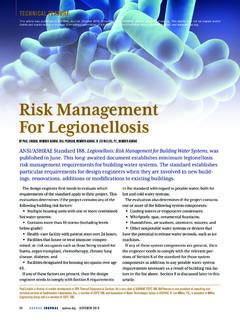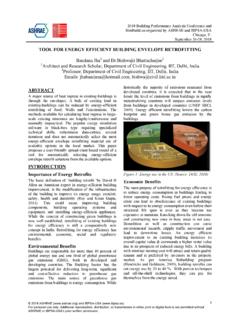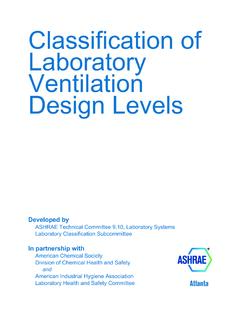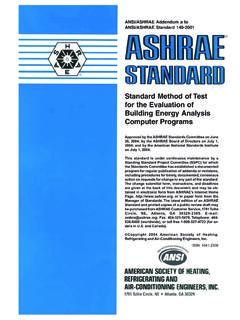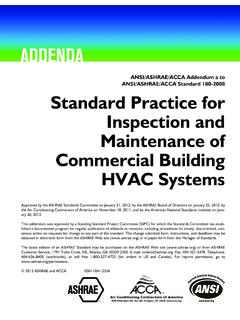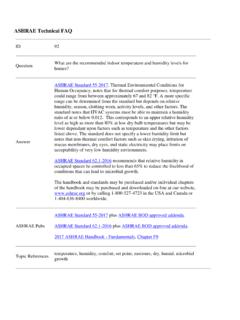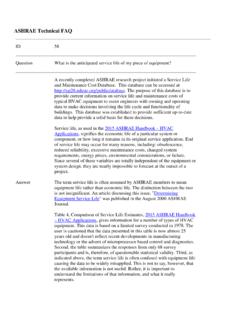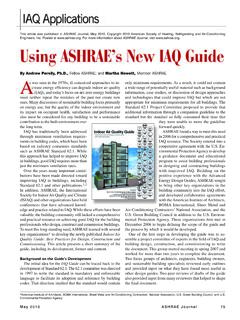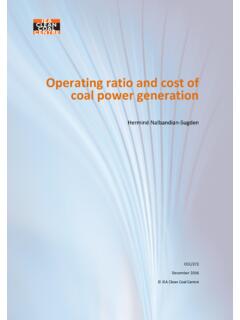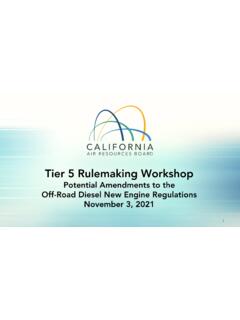Transcription of Ammonia as a Refrigerant - ASHRAE
1 1791 Tullie Circle, NE. Atlanta, Georgia 30329-2305, USA. ASHRAE Position Document on Ammonia as a Refrigerant Approved by ASHRAE Board of Directors February 1, 2017. Expires February 1, 2020. ASHRAE . S H A P I N G T O M O R R O W ' S B U I L T E N V I R O N M E N T T O D A Y. 2017 ASHRAE ( ). For personal use only. Additional reproduction, distribution, or transmission in either print or digital form is not permitted without ASHRAE 's prior written permission. COMMITTEE ROSTER. The ASHRAE Position Document on Ammonia as a Refrigerant was developed by the Society's Refrigeration Committee. Position Document Committee formed on January 8, 2016 with Dave Rule as its chair. Dave Rule, Chair Georgi Kazachki IIAR Dayton Phoenix Group Alexandria, VA, USA Dayton, OH, USA. Ray Cole Richard Royal Axiom Engineers, Inc. Walmart Monterey, CA, USA Bentonville, Arkansas, USA. Dan Dettmers Greg Scrivener IRC, University of Wisconsin Cold Dynamics Madison, WI, USA Meadow Lake, SK, Canada Derek Hamilton Azane Inc.
2 San Francisco, CA, USA. Other contributors: M. Kent Anderson Caleb Nelson Consultant Azane, Inc. Bethesda, MD, USA Missoula, MT, USA. Cognizant Committees The chairperson of Refrigerant Committee also served as ex-officio members: Karim Amrane REF Committee AHRI. Bethesda, MD, USA. i 2017 ASHRAE ( ). For personal use only. Additional reproduction, distribution, or transmission in either print or digital form is not permitted without ASHRAE 's prior written permission. HISTORY. of REVISION / REAFFIRMATION / WITHDRAWAL DATES. The following summarizes the revision, reaffirmation or withdrawal dates: 1/28/1993 Board of Directors approves Position Document titled Ammonia as a Refrigerant 1/17/2002 Board of Directors approves revised Position Document titled Ammonia as a Refrigerant 1/26/2006 Board of Directors approves reaffirmation of Position Document titled Ammonia as a Refrigerant 1/30/2010 Technology Council approves reaffirmation of Position Document titled Ammonia as a Refrigerant 6/30/2013 Technology Council approves reaffirmation of Position Document titled Ammonia as a Refrigerant 7/2/2014 Board of Directors approves revised Position Document titled Ammonia as a Refrigerant 2/1/2017 Board of Directors approves revised Position Document titled Ammonia as a Refrigerant Note.
3 Technology Counci l and t h e co gn i z an t com mitt ee re co m me n d revision, r e a f f ir m a t io n o r withdrawal every 30 months. ii 2017 ASHRAE ( ). For personal use only. Additional reproduction, distribution, or transmission in either print or digital form is not permitted without ASHRAE 's prior written permission. CONTENTS. ASHRAE Position Document on Ammonia as a Refrigerant . SECTION PAGE. Abstract ..1. Executive Summary ..2. 1. The Issue ..3. 2. Ammonia Specification and Refrigeration Uses of Health and Environmental Considerations of Ammonia as a Regulatory Risk 3. ASHRAE 's Strong Standards, Codes and Technology Transfer and iii 2017 ASHRAE ( ). For personal use only. Additional reproduction, distribution, or transmission in either print or digital form is not permitted without ASHRAE 's prior written permission. ABSTRACT. Ammonia has been continuously used as a Refrigerant since the initial practical use of the vapor- compression refrigeration cycle was developed.
4 It has remained the main Refrigerant used in industrial refrigeration systems because of its superior thermodynamic properties and low cost. Regulatory oversight on refrigerants such as CFC, HCFC, and other synthetic refrigerants, have re-focused attention on Ammonia to emerge as one of the widely used refrigerants that, when released to the atmosphere, does not contribute to ozone depletion and global warming. Ammonia is generally considered to be benign to the environment. ASHRAE encourages the continued use of Ammonia for - industrial and commercial refrigeration, food preservation, indirect space conditioning, heat pumps and other applications. ASHRAE participates in a variety of programs such as a dedicated chapter in the Refrigeration Handbook and several current and former research projects to promote the economic and environmental benefits of Ammonia refrigeration and will continue to provide guidance for the proper design, safe use and management of risk.
5 1. 2017 ASHRAE ( ). For personal use only. Additional reproduction, distribution, or transmission in either print or digital form is not permitted without ASHRAE 's prior written permission. EXECUTIVE SUMMARY. Globally, there is a growing interest in Ammonia as a Refrigerant , both by itself, and in cascade refrigeration systems with carbon dioxide and other secondary system designs. Regulatory oversight on CFC, HCFC, and other synthetic refrigerants, have re-focused attention on Ammonia to emerge as one of the widely used refrigerants that, when released to the atmosphere, does not contribute to ozone depletion and global warming. New technology and equipment is leading to low and reduced Ammonia charge designs. The application of these new low charge systems and packages creates an opportunity to use Ammonia systems in a broad range of industrial, commercial and indirect space conditioning applications that would not have been considered with traditional designs.
6 These changes will require industry to provide proper recommendations for both design safety and guidance for regulatory and code agencies. Ammonia is an efficient and popular Refrigerant due to its superior thermodynamic properties and low cost. Ammonia is environmentally benign, having zero GWP and zero ODP. It is hazardous when released in large quantities due to its toxicity. However, Ammonia does exhibit a unique Refrigerant characteristic due to its irritating odor. Persons exposed to an Ammonia release will not voluntarily stay near concentrations that are health-threatening. Although Ammonia will burn in a narrow range of high concentrations, it is difficult to ignite and will not support combustion after the ignition source is withdrawn. Ammonia has an ASHRAE flammability class of 2L, low flammability. ASHRAE encourages the continued use of Ammonia for industrial and commercial refrigeration, food preservation, indirect space conditioning, heat pumps and other applications.
7 ASHRAE . participates in a variety of programs to promote the economic and environmental benefits of Ammonia refrigeration and will continue to provide guidance for the proper design, safe use and management of risk. 2. 2017 ASHRAE ( ). For personal use only. Additional reproduction, distribution, or transmission in either print or digital form is not permitted without ASHRAE 's prior written permission. 1. THE ISSUE. Refrigerant selection has become increasingly complex in recent years. Globally, the interest in Ammonia and other natural refrigerants has become more focused due to increased regulatory oversite on the use of CFC, HCFC, and other synthetic refrigerants. The consideration of these refrigerants continues to come under question due to the environmental concerns caused from ozone depleting potential (ODP), global warming potential (GWP), energy efficiency, total equivalent warming impact (TEWI) and life cycle climate performance (LCCP).
8 Ammonia is a natural Refrigerant that has been used for many years in a variety of applications due to its high thermal efficiency. Since Ammonia is environmentally benign, having zero (GWP) and zero (ODP). characteristics, Ammonia is emerging as one of the primary natural refrigerants of choice. New technology is leading to low and reduced Ammonia charge designs. The application of these new low charge systems and packages creates an opportunity to use Ammonia in a broad range of new industrial, commercial and indirect space conditioning applications that would not have been considered with traditional designs. These changes will require industry to provide proper recommendations for both design safety and guidance for regulatory and code agencies. 2. BACKGROUND. Ammonia (chemical symbol NH3, United Nations Chemical #1005) is produced both naturally and as a byproduct of numerous man-made reactive processes.
9 Large amounts of naturally occurring Ammonia gas come from livestock animals, soil surfaces and even the human body. Manmade processes that emit Ammonia to the atmosphere include fuel combustion processes and sewage treatment plants. The nitrogen component of Ammonia was first recognized as an important fertilizer around 1840, and Ammonia was first used as a Refrigerant around 1850. Ammonia was first commercially produced in the United States about 1880 as a distillation by-product of coal processing to produce coke and coal gas. The first direct-synthesis commercial process was developed in Germany by Fritz Haber and Carl Bosch in 1913. The wide variety of Ammonia uses throughout agriculture and industry, combined with varied and highly efficient manufacturing processes, has kept the costs of commercially manufacturing Ammonia low. Natural gas is one of the feedstocks used for large scale Ammonia production.
10 The rapid increase in the availability of natural gas in the and elsewhere due to new drilling technologies has kept the cost of this feedstock down, helping to keep down the cost of the Ammonia product. Ammonia Specification and Applications Ammonia is an alkaline, colorless chemical compound that is well recognized as the basis for household cleaning products. It also has many agricultural, industrial and commercial uses. It is available in five generally recognized grades fertilizer, Refrigerant , federal, metallurgical, and semiconductor depending on its level of purity. Refrigeration grade Ammonia is percent pure and is relatively free of water and other impurities (maximum: 150 ppm water, 3 ppm oil, ml/g non-condensibles). It is readily available, inexpensive, operates at pressures comparable with other refrigerants and is capable of absorbing large amounts of heat when it evaporates. 3.
